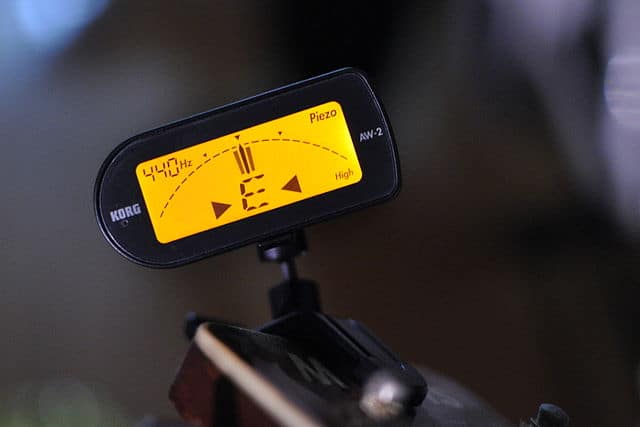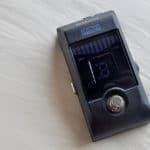An out-of-tune guitar is a futile instrument.
Better not to play at all, than to play it wrong. Don’t you think?
It’s a miracle that guitar turners are a thing. They help guitarists find the right note and create wonderful music.
Unfortunately, guitar tuners are not 100% reliable.
Believe it or not, the tuner may confuse strings, and show you a different note from the one you’re looking for.
Why’s this possible?
Tuners might confuse guitar strings because the current string the player is tuning is too out of tune. Since tuners work by picking up the closest frequencies being played, it’s normal for these devices to confuse strings and grasp another note. It’s advisable to learn to tune by ear to avoid this problem.
Time to focus on this topic in a more detailed way.
If this is a recurrent problem, here’s what you need to know and do.
What could cause a tuner to confuse guitar strings?
Sometimes, the guitar tuner may confuse the guitar strings right note.
For example, you are trying to tune the D string (in standard tuning), but the tuner will show it is perceiving the A string.
This is mainly because the string is so out of tune that the tuner grasps it as a different note, and thus, a different string.
If the string has altered its tuning so much, then it’s natural that the tuner shows another letter.
More often than not, this is not because the tuner is broken, or because it’s malfunctioning.
On the contrary, it’s perceiving the right note. Unfortunately, it’s perceiving it on another string.
Consider that tuners sense the pitch of the string, then show the most accurate note of that pitch. After all, tuners are rarely 100% accurate.
So, if the string is slightly out of tune (half a step; one full step; two full steps), then it will be easier for the tuner to grasp the accurate tuning.
However, if the string is either too high or too low, then the tuner screen will display the closest note, which might not be the one you’re looking for.
This won’t always be the case, but it might show up sooner or later.
Another reason is that the tuner grasps the overtones of the note. This leads to a “false reading.”
If any of these causes has happened to you, then take it easy.
There are some solutions that you may implement to find the note you’re looking for.
How could you tune your guitar if your tuner is messing the strings up?
Nowadays, the most common way of tuning a guitar is by using a tuner.
Generally, this is done either with a real tuner or an app. Both forms are undoubtedly effective.
Nonetheless, there are other forms of tuning, in case the tuner is malfunctioning (or you don’t have one at all!).
The most obvious approach is tuning by ear. This, however, is not possible for everyone.
Consider how many players (especially beginners) find this hard to accomplish. Fortunately, this doesn’t have to be like this forever.
Contrary to what some people believe, ear-tuning is a skill that can be developed; not a gift that one is born with.
Sharpening one’s ear takes time. Naturally, the more you play, and the more you practice, the sooner you’ll develop this ability.
Not to mention, it’s strictly related to getting used to how the guitar sounds as well.
In other words, if you regularly play guitar, you’ll inevitably differentiate a tuned chord from an out-of-tune one.
That way, you may tune the strings by ear until you find the chords sound okay.
You may play a song you like as a reference, then apply changes accordingly.
What’s more, you can tune the string by finding a reference note.
For example, suppose you’re trying to tune the G string (standard). Therefore, play the fifth fret in the D string, and tune the G string until you find a similar sound between the two strings.
This might not be as accurate as utilizing a tuner, but at least you’ll get pretty close. Not to mention, is a great exercise to sharpen your ear.
Another solution you can implement is changing your old guitar strings with brand-new ones.
Although this is more time-consuming, it’s a fact that old strings provide a duller tone, which tuners might not pick up perfectly.
Lastly, if you’re using a clip-on tuner, move it to a different area of the headstock and check whether it works or not.
Is it something wrong with the tuner or the guitar?
As a general rule, it’s more probable that the problem has to do with the tuner than the guitar.
Nonetheless, we could argue that is neither an issue with the guitar nor the tuner, but with the strings. To be more precise, it is with how the strings are tuned.
Once again, consider that the tuner will pick up the closest note the string creates.
This means that, if the string is too out of tune, then the tuner will grasp the closest note (contrarily to the note you expect it to find), and understand it’s coming from a different string.
Consider that the tuner is, ironically, right and wrong at the same time.
Although it’s perceiving the proper note due to the overtone issue, it’s not achieving the results you’re expecting to get.
Now, it would be almost impossible that the problem is strictly related to the guitar, so don’t worry.
Is there a way of fixing the tuner if it takes the strings wrong?
Let’s suppose that the problem is not the string or the overtone.
For once, we’ll say the tuner is completely messed up. If that’s the case, then what can you do?
First of all, check that the batteries are full. Maybe the tuner’s power source is running out of energy.
If that’s the case, then it’s natural for the tool to malfunction.
Replace the batteries with some newer ones and you’ll be tuning your guitar accurately in the blink of an eye.
Now, if you’re working with a clip-on tuner with full-charged batteries, then move it around the guitar’s headstock until it picks up the right frequencies.
Lastly, we would encourage you to try tuning with a different tuner.
If your physical tuner won’t work, just download a tuning app. Use it until you can replace your original tuner.
Is it worth it to learn to tune by ear?
One of the wisest decisions a guitar player could take is learning to tune by ear.
After all, they are musicians, and the more they develop their ears, the better.
Tuning by ear is a healthy exercise that, all in all, turn anyone into a better professional.
Not to mention, having this ability is quite useful.
Bear in mind that you won’t have a guitar tuner at hand every time. Luckily, those who know how to tune by ear won’t find a problem with it.
If you’re still not convinced, then it’s because you don’t know all the many benefits that tuning by ear brings to you.
So, we encourage you to check this article we did some time ago. You’ll realize how much of a joy it is to tune your guitar on your own.

Hello there, my name is Ramiro and I’ve been playing guitar for almost 20 years. I’m obsessed with everything gear-related and I thought it might be worth sharing it. From guitars, pedals, amps, and synths to studio gear and production tips, I hope you find what I post here useful, and I’ll try my best to keep it entertaining also.





